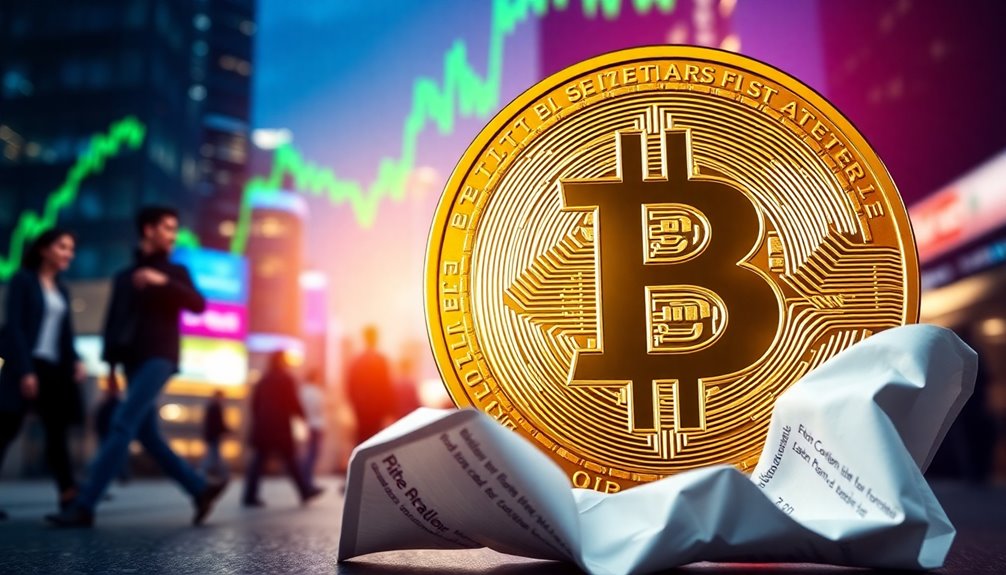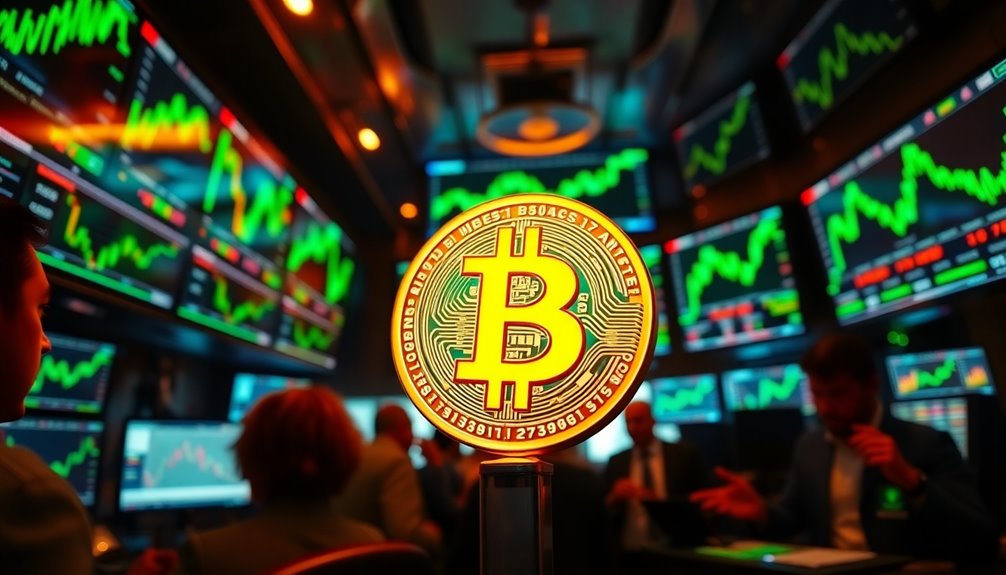Bitcoin's incredible rise past $100,000 proves it's thriving, even in the face of skepticism. You can see how it outperformed traditional assets like gold and stocks recently. Institutional interest is booming, with companies like MicroStrategy and Tesla investing heavily, reinforcing Bitcoin's status as a solid investment. Regulatory shifts are also paving the way for clearer frameworks, making crypto adoption smoother for many. Active trading is increasing, showing a vibrant market. As Bitcoin challenges the doubters more than ever, it's a perfect time to explore what this means for its future potential.
Key Takeaways
- Bitcoin's price surged past $100,000, reflecting a 32% increase in just one month amid skepticism from traditional investors.
- Institutional interest and strong market demand position Bitcoin as a reliable hedge against economic uncertainty, enhancing its stability.
- Recent regulatory changes, like the EU's MiCA, provide clearer frameworks, boosting confidence and institutional adoption of Bitcoin.
- Corporate treasury investments from firms like MicroStrategy and Tesla demonstrate growing acceptance and belief in Bitcoin's long-term potential.
- Despite regulatory challenges, Bitcoin's market dominance has risen, capturing 54% of the $3.7 trillion crypto market, proving its resilience.
Bitcoin's Resilience Amid Skepticism

While many skeptics voice concerns about Bitcoin's viability, the cryptocurrency continues to demonstrate remarkable resilience.
You've probably noticed Bitcoin's recent price surge, surpassing $100,000 even amidst global economic tensions. Unlike traditional assets like gold and stocks, which have declined, Bitcoin's value skyrocketed by 32% in just a month. This increase comes in stark contrast to traditional markets, which faced declines during the same period.
Market indicators like the Net Unrealized Profit/Loss show it's in a phase of "euphoria," hinting at prolonged increases ahead. With analysts predicting growth momentum extending until the end of 2025, Bitcoin's appeal is solidified.
Despite a strong dollar, strong market demand and institutional interest keep bolstering its price stability, making it an attractive hedge against economic uncertainty.
Bitcoin is proving doubters wrong time and again.
Regulatory Changes Impacting Bitcoin

Bitcoin's impressive growth isn't just a story of market demand; it's also influenced by evolving regulatory landscapes.
Internationally, frameworks like the EU's MiCA regulation and OECD's CARF are shaping digital asset oversight and tax reporting. However, a lack of global consensus creates enforcement challenges.
In the U.S., federal shifts signal a move towards a clearer regulatory framework, with pro-crypto officials being appointed and discussions around a national Bitcoin reserve gaining traction. This anticipated framework is expected to enhance institutional adoption of Bitcoin and other digital assets.
State-level regulations, especially in Wyoming and Texas, promote innovation while establishing specific guidelines for crypto activities.
Meanwhile, updated accounting standards demand greater transparency and fair value measurement, ensuring businesses provide detailed information about their digital assets.
These changes are pivotal for Bitcoin's future.
Bullish Trading Volume Spikes

As bullish trading volume spikes across major exchanges, it's clear the market is buzzing with activity.
On Binance alone, over 25,000 BTC changed hands, signaling a vibrant trading environment.
Huobi's BTC/ETH pair saw 5,000 BTC traded, revealing a shift in investor focus toward Bitcoin.
Bitfinex reported 8,000 BTC trading for BTC/USD, reinforcing this bullish momentum.
The technical indicators support these moves, with Bitcoin breaking past $46,000 and surpassing its 50-day moving average. Notably, this rapid BTC price increase was accompanied by an increase in active addresses, suggesting broader market participation.
Retail investors are increasingly active, evident through a rise in on-chain addresses.
While the market displays strong bullish sentiment and liquidity, keep an eye on overbought conditions, as the RSI levels suggest potential short-term corrections ahead.
Stay vigilant!
Corporate Treasury Investments

The surge in bullish trading volume isn't just attracting retail investors; corporations are also recognizing the potential of Bitcoin as a strategic asset for their treasuries.
Companies like MicroStrategy and Tesla have already allocated substantial portions of their balance sheets to Bitcoin, viewing it as a hedge against inflation and currency devaluation. Recent surveys indicate that 58% of institutional investors currently hold cryptocurrency, demonstrating the growing acceptance of Bitcoin in corporate finance. Furthermore, just as with gold IRAs, corporations can utilize Bitcoin as a means to diversify their investment portfolios.
The enhanced liquidity and higher returns of Bitcoin compared to traditional assets make it an appealing choice for diversifying corporate portfolios.
However, the volatility and regulatory uncertainty associated with Bitcoin require careful risk management.
By partnering with experienced digital asset providers, you can navigate these complexities and position your company as a leader in the growing trend of corporate Bitcoin adoption.
Embracing this asset class could offer a significant competitive edge.
Government Policies and Market Reactions

While navigating the complex landscape of cryptocurrency, it's essential to understand how government policies shape market dynamics. Regulatory actions can significantly impact Bitcoin's price. For instance, China's ICO ban caused a notable price drop, but Bitcoin quickly rebounded.
Conversely, Japan's recognition of cryptocurrencies as legal tender resulted in a price spike. When regulations are clear, investor confidence often increases, as seen during Trump's pro-crypto administration. Moreover, positive regulation can lead to price increases due to increased legitimacy. Additionally, historical performance of Bitcoin often reflects how it responds to regulatory changes, highlighting its resilience in the face of adversity.
However, uncertainty can lead to volatility. Recent scrutiny of decentralized finance platforms and proposed tax reforms may complicate the market.
Ultimately, effective regulation can reduce risks and boost confidence, but fluctuating policies will continue to challenge Bitcoin's stability and growth.
Long-Term Adoption Trends

Given the increasing interest in Bitcoin, it's clear that long-term adoption trends are shaping the future of cryptocurrency.
You might notice that institutional players like Blackrock and Fidelity are diving into Bitcoin, signaling a shift in perception. Currently, Bitcoin holds 54% of the $3.7 trillion crypto market, up from 38% just last year. This growth isn't confined to high-income nations; lower-middle-income countries are leading the charge in crypto adoption.
Despite skepticism among Americans—where only 5% express strong confidence—global interest continues to rise, especially with potential catalysts like federal interest rate cuts. As blockchain development progresses, addressing key challenges will be essential, paving the way for Bitcoin’s enduring presence in the financial landscape. This evolving scenario highlights a growing divergence between domestic skepticism and international enthusiasm for cryptocurrency innovations. As investors and institutions increasingly recognize the potential of digital assets, bitcoin optimism and future goals are becoming central themes in market discussions. By focusing on technological advancements and regulatory clarity, the crypto community aims to solidify Bitcoin’s role as a viable financial instrument and a hedge against inflation in increasingly uncertain economic climates.
Frequently Asked Questions
How Does Bitcoin Compare to Traditional Currencies in Value Retention?
When comparing Bitcoin to traditional currencies in value retention, you'll notice its fixed supply of 21 million coins creates scarcity, helping it retain value over time.
Unlike fiat currencies, Bitcoin isn't subject to inflation caused by central banks. Its divisibility allows for precise transactions, while growing acceptance enhances its usability.
Additionally, Bitcoin's digital nature ensures portability and durability, making it a compelling alternative for those seeking a reliable store of value.
What Are the Environmental Impacts of Bitcoin Mining?
Imagine a dragon hoarding gold, but at a steep cost.
Bitcoin mining's environmental impacts are striking. You're looking at a carbon footprint larger than some countries, with each transaction emitting tons of CO₂.
Water use is significant, too, as miners tap into precious resources.
With land footprints growing, you might wonder if the treasure is worth the toll.
It's a delicate balance between innovation and sustainability that you can't ignore.
How Do Bitcoin Forks Affect the Cryptocurrency Market?
Bitcoin forks significantly impact the cryptocurrency market by creating new assets that often lead to price fluctuations.
When a fork occurs, you usually receive an equivalent amount of the new cryptocurrency, which can diversify your portfolio without extra investment.
However, the new asset's value is uncertain and highly volatile, so you'll need to stay informed.
Additionally, forks can cause community divisions and complicate network operations, leading to further volatility.
What Role Do Influencers Play in Bitcoin's Price Movements?
Influencers significantly impact Bitcoin's price movements. When you follow their posts, you notice how bullish statements can lead to price surges.
They create excitement and speculation, triggering FOMO among investors. The timing of their content matters too; a well-timed video or tweet can provoke immediate reactions in the market.
How Can Individuals Securely Store Their Bitcoin Assets?
To securely store your Bitcoin assets, consider using cold storage methods like hardware wallets or paper wallets.
You should also set up multi-signature wallets for added security, requiring multiple approvals for transactions.
Always back up your seed phrase and store it in a secure location.
Utilizing a security-focused operating system can further protect your transactions.
Regularly update your devices and educate yourself on best practices to minimize risks effectively.
Conclusion
So, despite the skeptics shaking their fists and shouting doomsday prophecies, Bitcoin's still strutting its stuff like a peacock in a tuxedo. With trading volumes soaring and corporations treating crypto like their new favorite pet, you've got to wonder if the doubters are just stuck in a time loop, waiting for dial-up internet to come back. While they sip their lukewarm coffee, Bitcoin's out there rewriting the rules, proving once again that it's the unstoppable party crasher of finance.









